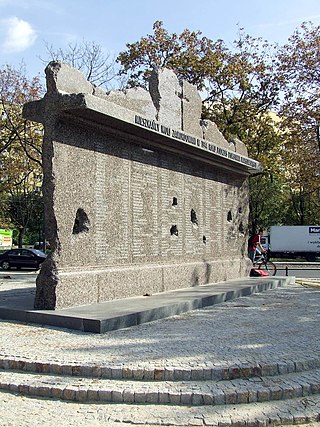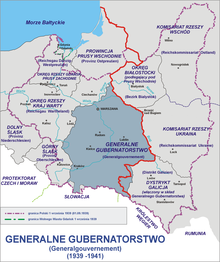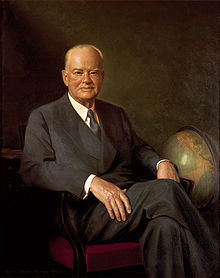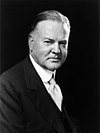
The General Government, also referred to as the General Governorate for the Occupied Polish Region, was a German zone of occupation established after the invasion of Poland by Nazi Germany, Slovakia and the Soviet Union in 1939 at the onset of World War II. The newly occupied Second Polish Republic was split into three zones: the General Government in its centre, Polish areas annexed by Nazi Germany in the west, and Polish areas annexed by the Soviet Union in the east. The territory was expanded substantially in 1941, after the German Invasion of the Soviet Union, to include the new District of Galicia. The area of the Generalgouvernement roughly corresponded with the Austrian part of the Polish–Lithuanian Commonwealth after the Third Partition of Poland in 1795.

The history of Poland from 1939 to 1945 encompasses primarily the period from the invasion of Poland by Nazi Germany and the Soviet Union to the end of World War II. Following the German–Soviet non-aggression pact, Poland was invaded by Nazi Germany on 1 September 1939 and by the Soviet Union on 17 September. The campaigns ended in early October with Germany and the Soviet Union dividing and annexing the whole of Poland. After the Axis attack on the Soviet Union in the summer of 1941, the entirety of Poland was occupied by Germany, which proceeded to advance its racial and genocidal policies across Poland.

Żegota was the Polish Council to Aid Jews with the Government Delegation for Poland, an underground Polish resistance organization, and part of the Polish Underground State, active 1942–45 in German-occupied Poland. Żegota was the successor institution to the Provisional Committee to Aid Jews and was established specifically to save Jews. Poland was the only country in German-occupied Europe where such a government-established and -supported underground organization existed.

The Generalplan Ost, abbreviated GPO, was Nazi Germany's plan for large-scale ethnic cleansing, extermination and genocide of Slavs, Eastern European Jews and other ethnic groups categorised as "Untermensch" in Nazi ideology. The plan was intended to be the precursor for a programme, which would involve the colonisation of Central and Eastern Europe by German settlers, after the elimination of national identities of various Slavic peoples.

Operation Tannenberg was a codename for one of the anti-Polish extermination actions by Nazi Germany that were directed at the Poles during the opening stages of World War II in Europe, as part of the Generalplan Ost for the German colonization of the East. The shootings were conducted with the use of a proscription list, compiled by the Gestapo in the span of two years before the 1939 invasion.

Around six million Polish citizens are estimated to have perished during World War II. Most were civilians killed by the actions of Nazi Germany, the Soviet Union, the Lithuanian Security Police, as well as the Organization of Ukrainian Nationalists and its offshoots.
Mass evacuation, forced displacement, expulsion, and deportation of millions of people took place across most countries involved in World War II. A number of these phenomena were categorised as violations of fundamental human values and norms by the Nuremberg Tribunal after the war ended. The mass movement of people – most of them refugees – had either been caused by the hostilities, or enforced by the former Axis and the Allied powers based on ideologies of race and ethnicity, culminating in the postwar border changes enacted by international settlements. The refugee crisis created across formerly occupied territories in World War II provided the context for much of the new international refugee and global human rights architecture existing today.
Following the establishment of the Second Polish Republic after World War I and during the interwar period, the number of Jews in the country grew rapidly. According to the Polish national census of 1921, there were 2,845,364 Jews living in the Second Polish Republic; by late 1938 that number had grown by over 16 percent, to approximately 3,310,000, mainly through migration from Ukraine and the Soviet Russia. The average rate of permanent settlement was about 30,000 per annum. At the same time, every year around 100,000 Jews were passing through Poland in unofficial emigration overseas. Between the end of the Polish–Soviet War of 1919 and late 1938, the Jewish population of the Republic grew by nearly half a million, or over 464,000 persons. Jews preferred to live in the relatively-tolerant Poland rather than in the Soviet Union and continued to integrate, marry into Polish Gentile families, to bring them into their community through marriage, feel Polish and form an important part of Polish society. Between 1933 and 1938, around 25,000 German Jews fled Nazi Germany to sanctuary in Poland.

The Holocaust in Poland was the ghettoization, robbery, deportation, and murder of Jews in occupied Poland, organized by Nazi Germany. Three million Polish Jews were murdered, primarily at the Chelmno, Belzec, Sobibor, Treblinka, and Auschwitz II–Birkenau extermination camps, representing half of all Jews murdered during the Europe-wide Holocaust.

Crimes against the Polish nation committed by Nazi Germany and Axis collaborationist forces during the invasion of Poland, along with auxiliary battalions during the subsequent occupation of Poland in World War II, consisted of the genocide of millions of Polish people, including the systematic extermination of Jewish Poles. These mass-killings were enacted by the Nazis with further plans that were justified by their racial theories, which regarded Poles and other Slavs, and especially Jews, as racially inferior Untermenschen.

The Commission for Relief in Belgium or CRB − known also as just Belgian Relief − was an international organization that arranged for the supply of food to German-occupied Belgium and northern France during the First World War.
The Hunger Plan was a partially implemented plan developed by Nazi bureaucrats during World War II to seize food from the Soviet Union and give it to German soldiers and civilians. The plan entailed the genocide by starvation of millions of Soviet citizens following Operation Barbarossa, the 1941 invasion of the Soviet Union. The premise behind the Hunger Plan was that Germany was not self-sufficient in food supplies; to sustain the war and keep up domestic morale, it needed food from conquered lands at any cost. The plan created a famine as an act of policy, killing millions of people.

Polish Jews were the primary victims of the Nazi Germany-organized Holocaust in Poland. Throughout the German occupation of Poland, Jews were rescued from the Holocaust by Polish people, at risk to their lives and the lives of their families. According to Yad Vashem, Israel's official memorial to the victims of the Holocaust, Poles were, by nationality, the most numerous persons identified as rescuing Jews during the Holocaust. By January 2022, 7,232 people in Poland have been recognized by the State of Israel as Righteous among the Nations.

The Expulsion of Poles by Nazi Germany during World War II was a massive operation consisting of the forced resettlement of over 1.7 million Poles from the territories of German-occupied Poland, with the aim of their Germanization between 1939 and 1944.

Around 6 million Polish citizens perished during World War II: about one fifth of the pre-war population. Most were civilian victims of the war crimes and crimes against humanity during the occupation by Nazi Germany and the Soviet Union. Approximately half were Polish Jews killed in The Holocaust. Statistics for Polish World War II casualties are divergent and contradictory. This article provides a summarization of these estimates of Poland's human losses in the war and their causes.

During the German Occupation of Poland (1939–1945), the Nazis brutally suppressed the Catholic Church in Poland, most severely in German-occupied areas of Poland. Thousands of churches and monasteries were systematically closed, seized or destroyed. As a result, many works of religious art and objects were permanently lost.

The occupation of Poland by Nazi Germany and the Soviet Union during World War II (1939–1945) began with the German-Soviet invasion of Poland in September 1939, and it was formally concluded with the defeat of Germany by the Allies in May 1945. Throughout the entire course of the occupation, the territory of Poland was divided between Nazi Germany and the Soviet Union (USSR), both of which intended to eradicate Poland's culture and subjugate its people. In the summer-autumn of 1941, the lands which were annexed by the Soviets were overrun by Germany in the course of the initially successful German attack on the USSR. After a few years of fighting, the Red Army drove the German forces out of the USSR and crossed into Poland from the rest of Central and Eastern Europe.
During the German occupation of Poland, some citizens of all its major ethnic groups collaborated with the Germans. Estimates of the number of collaborators vary. Collaboration in Poland was less institutionalized than in some other countries and has been described as marginal, a point of pride with the Polish people. During and after the war, the Polish government in exile and the Polish resistance movement punished collaborators and sentenced to death thousands of them.

The Polish White Book is a semi-official name of a series of comprehensive reports published during World War II by the Ministry of Information of the Polish government-in-exile in London, England, dealing with Polish-German relations before and after the 1939 German-Soviet aggression against Poland. Each publication, released in English, French, German and Polish between 1940 and 1941, consisted of official documents and affidavits, supplemented with an overview by the Ministry. Notably, the Polish White Book was released in parallel with The Black Book of Poland series by G.P. Putnam's Sons of New York, published in London by Hutchinson & Co under a differing title in 1942.
Food and agriculture in Nazi Germany describes the food and agricultural policies of Nazi Germany and their consequences from 1933 when the Nazis took power in Germany until 1945 when Germany was defeated in World War II (1939–1945) by the allied nations. Starvation and its associated illnesses killed about 20 million people in Europe and Asia during World War II, approximately the same as the number of soldiers killed in battle. Most of the deaths from starvation in Europe were in the Soviet Union and Poland, countries invaded by Germany and occupied in whole or part during the war.


















